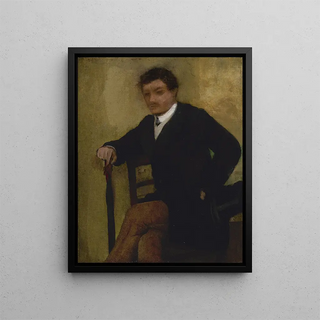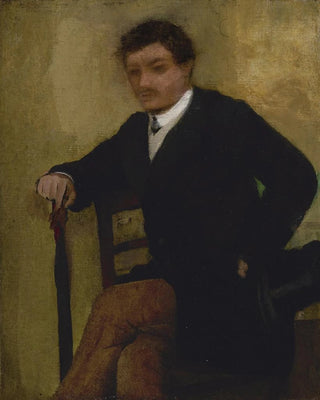Art print | Portrait of a seated man - Edgar Degas


View from behind

Frame (optional)
Edgar Degas's "Seated Man Portrait" is a work that transcends the simple frame of painting to establish itself as a true exploration of the nuances of the human soul. Created at the end of the 19th century, this painting reveals a fascinating psychological depth, where each brushstroke seems to capture not only the external appearance of the subject but also his thoughts and emotions. In this representation, Degas does not merely freeze a moment; he invites the viewer to delve into the intimacy of a man, to question his experiences and aspirations. The magic of this artwork lies in its ability to evoke a personal connection, to inspire reflections on the nature of identity and portraiture.
Style and uniqueness of the work
Degas's style is distinguished by his innovative approach to portraiture. Unlike his contemporaries who often favored idealized representations, the artist chooses here to capture a more raw and authentic reality. The lines are both fluid and precise, creating a dynamic that animates the character. The interplay of shadow and light adds an almost sculptural dimension to the piece, giving the seated man a tangible presence. Degas uses subtly nuanced colors, oscillating between warm and cool tones, to express the complex emotions of the subject. Every detail, from the fold of the clothing to the expression on the face, contributes to the atmosphere of melancholy and reflection emanating from this canvas. This stylistic singularity makes the "Seated Man Portrait" an emblematic work, revealing the genius of an artist who knows how to capture the very essence of his models.
The artist and his influence
Edgar Degas, a central figure of the Impressionist movement, is often regarded as a pioneer in the depiction of movement and everyday life. His work goes beyond simple portraits, incorporating elements of dance, café life, and urban scenes, demonstrating a meticulous observation of society of his time. Degas's influence is felt not only in painting but also in photography and sculpture, where he was able to infuse his unique vision. His introspective approach to portraiture

Matte finish

View from behind

Frame (optional)
Edgar Degas's "Seated Man Portrait" is a work that transcends the simple frame of painting to establish itself as a true exploration of the nuances of the human soul. Created at the end of the 19th century, this painting reveals a fascinating psychological depth, where each brushstroke seems to capture not only the external appearance of the subject but also his thoughts and emotions. In this representation, Degas does not merely freeze a moment; he invites the viewer to delve into the intimacy of a man, to question his experiences and aspirations. The magic of this artwork lies in its ability to evoke a personal connection, to inspire reflections on the nature of identity and portraiture.
Style and uniqueness of the work
Degas's style is distinguished by his innovative approach to portraiture. Unlike his contemporaries who often favored idealized representations, the artist chooses here to capture a more raw and authentic reality. The lines are both fluid and precise, creating a dynamic that animates the character. The interplay of shadow and light adds an almost sculptural dimension to the piece, giving the seated man a tangible presence. Degas uses subtly nuanced colors, oscillating between warm and cool tones, to express the complex emotions of the subject. Every detail, from the fold of the clothing to the expression on the face, contributes to the atmosphere of melancholy and reflection emanating from this canvas. This stylistic singularity makes the "Seated Man Portrait" an emblematic work, revealing the genius of an artist who knows how to capture the very essence of his models.
The artist and his influence
Edgar Degas, a central figure of the Impressionist movement, is often regarded as a pioneer in the depiction of movement and everyday life. His work goes beyond simple portraits, incorporating elements of dance, café life, and urban scenes, demonstrating a meticulous observation of society of his time. Degas's influence is felt not only in painting but also in photography and sculpture, where he was able to infuse his unique vision. His introspective approach to portraiture






